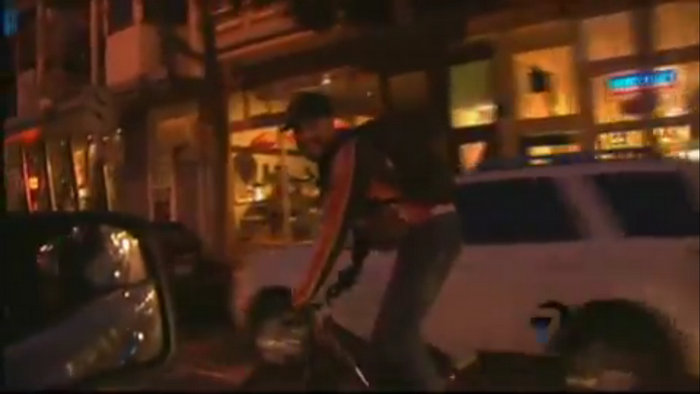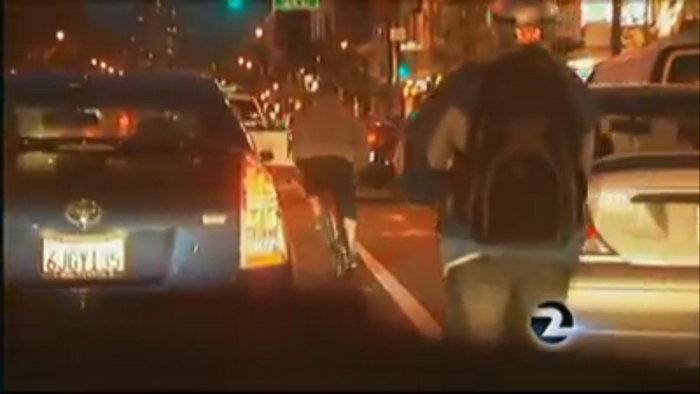Last week, KTVU 2 reporter David Stevenson drove down Valencia Street, yelling at bicycle riders through the window of his motor vehicle, asking where their helmets were. He even brought a camera crew to film it -- oddly enough, in the name of bicycle safety.

"As twilight descends," Stevenson told viewers, "the most vulnerable of the crowd dodge dangers on every block."
"Dangers"... like distracting them by shouting through the passenger window, pointing a TV camera at their faces?
Stevenson's behavior seemed to border on an offense that's suable under Berkeley's new bicyclist anti-harassment law, had it taken place in that city. As a colleague of mine put it, driving down Valencia yelling, "Where's your helmet?" at bike riders is like waving a loaded gun in the air and yelling, "Where's your bullet-proof vest?"
At best, Stevenson's report was a sloppy analysis of bike safety that neglects to field any perspective from bicycle advocates or research the actual causes of bicycle crashes and injuries. The segment simply cited the numbers of bicycle riders killed and injured, then implied that helmets and lights are the most effective solution for preventing deaths and injuries. Stevenson made no effort to weigh factors like driver inattention or speed, which can have deadly consequences. (Speeders are, of course, harder to harangue from the passenger seat than cyclists.)
There's nothing wrong with the friendly promotion of bike lights as an essential tool for night visibility (though Stevenson did point to bicyclists without lights in daylight).
But if Stevenson had even grazed the tip of the iceberg on the complex debate around bike helmets, he'd find there's far from any consensus about their efficacy as a safety measure. No doubt, wearing one is (and should be) a personal choice. But for starters, Stevenson might have looked into why the European Cyclists Federation, comprised of 65 bicycle coalitions in 39 countries, actively campaigns against mandatory helmet laws and "shock-horror" helmet promotions that unrealistically depict bicycling as an abnormally dangerous activity. As worldwide Danish bicycling advocate Mikael Colville-Andersen of Copenhagenize is keen to point out, there's little evidence to support the notion that riding a bike carries a higher risk of head injury than many other everyday activities like walking, climbing stairs, or driving.
And if Stevenson was truly concerned about bike safety in the Bay Area, he might note the danger of dooring, the single most common cause of motorist-induced injury suffered by San Francisco bicyclists. He might also wonder about the drivers whom he taped stopping in the bike lane on Valencia, and why such streets lack safer designs like protected bike lanes.

It's too late for KTVU to take back this particular affront to the public discussion about street safety. But here's an intriguing datapoint for a potential follow-up: An Australian study suggested that mandating helmets for motorists could potentially save 17 times as many lives as a bicycle helmet law (without the adverse impacts of discouraging bicycling and reducing the "safety in numbers" effect [PDF]).




